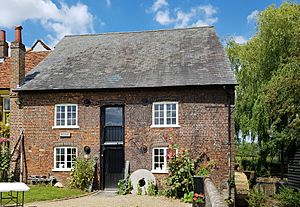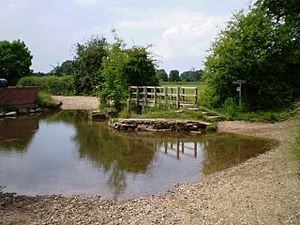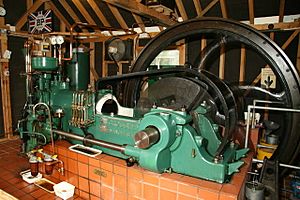Redbournbury Mill facts for kids
Quick facts for kids Redbournbury Mill |
|
|---|---|
 |
|
| Type | Watermill |
| Location | Redbournbury Lane, Redbournbury |
| OS grid reference | TL 11855 10775 |
| Area | Hertfordshire |
| Built | 1780 |
| Owner | Private |
|
Listed Building – Grade II*
|
|
| Official name: Redbournbury Mill, including front railings | |
| Designated | 27 September 1984 |
| Reference no. | 1175121 |
| Lua error in Module:Location_map at line 420: attempt to index field 'wikibase' (a nil value). | |
Redbournbury Mill is a historic flour mill in Hertfordshire, England. It is a Grade II* listed building, which means it is officially protected because of its special importance.
A mill has stood on this site for nearly 1,000 years. It was first built as a watermill, using the power of the River Ver to grind grain into flour. Today, the mill is powered by a diesel engine.
Contents
A Mill Through History
From Domesday to Royalty
The first record of a mill at Redbournbury comes from the famous Domesday Book of 1086. This was a huge survey of England ordered by William the Conqueror. Before that, around the year 1030, the land was given to the Abbot of St Albans. The mill was known as Chamberlain's Mill because the Abbot's chamberlain (a high-ranking official) lived in the nearby farmhouse.
In 1290, the mill burned down in a fire that almost destroyed the whole area. Luckily, the local woods helped to stop the flames from spreading.
Later, during the Tudor period, big changes happened in England. King Henry VIII took control of all the lands owned by the church, including the mill. When he died, the mill was passed down to his daughter, Princess Elizabeth. After she became queen and died, her successor, King James I, inherited it.
New Owners and Unique Features
King James I began leasing the mill, now called "Redbourne Greate Mill," to private renters. In 1652, a lawyer and politician named Sir Harbottle Grimston bought the mill. It became part of his family's large Gorhambury Estate.
The mill building that you can see today was built around 1780. Over the years, it was upgraded with new machinery. One of its most special features is the layout of its three millstones. These heavy stones grind the grain.
Usually, millstones are arranged in a circle around a central gear. But at Redbournbury, they are set in a single straight line. This is the only known example in Hertfordshire and is very rare in the United Kingdom.
The Story of Ivy Hawkins
In 1841, a man named Edward Hawkins became the miller. His family would run the mill for the next 144 years. Edward's great-granddaughter, Ivy Hawkins, was the last of the family to work there.
Ivy started milling in 1916 when she was just 19 years old. She lived and worked at the mill until 1985. In 1956, she had a very dangerous accident. While trying to fix the waterwheel, she became trapped inside it for over an hour. She was rescued and, after a short hospital stay, returned home safely.
Three years later, a newspaper called The Times wrote an article about her. It called her "Britain's only lady miller," which made her famous across the country.
Revival and Modern Times
Fire and Restoration
After Ivy Hawkins left in 1985, the mill was sold to the James family in 1987. They wanted to restore it to a working mill again, as it hadn't been used to make flour since the 1950s.
Just days after they started work, a fire broke out in the roof. The fire destroyed most of the inside of the mill and the house. Thankfully, the important gears that run the mill were saved. This meant the mill could still be restored.
The restoration project took ten years. The owners also repaired a large diesel engine to power the mill. The River Ver is not as strong as it used to be, so its water can no longer turn the heavy millstones on its own.
The Bakery and Local Flour
In 2005, a bakery was built in one of the old barns at the mill. It opened to the public in 2006. The bakery sells bread and cakes made with flour ground right there in the mill.
The wheat and other cereals used to make the flour are grown at Hammonds End farm, which is less than two miles away. This means the ingredients have very low food miles (the distance food travels to get to you). This is great for the environment.
Famous on TV
Redbournbury Mill has appeared on several TV shows.
- In 2013, celebrity baker Paul Hollywood visited for his show Paul Hollywood's Bread.
- In 2016, his co-host from The Great British Bake Off, Mary Berry, filmed at the mill for a programme about the Alban bun. This bun is thought to be an early version of the Hot cross bun.
- Chef Jay Rayner also visited in 2013 for BBC One's The One Show to learn about the Alban bun.



